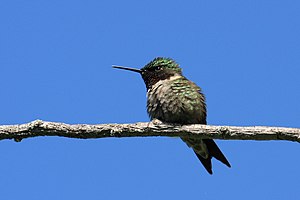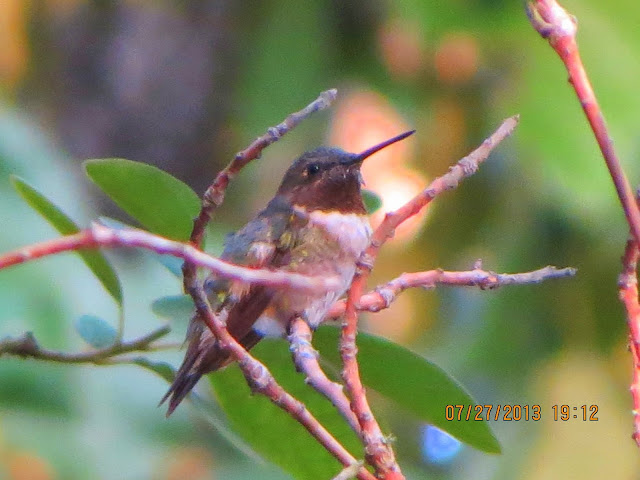Hi Everybody!!
I think I told You last week that Elvis (the hummingbird) is already here with a few others. He looks like a typical Ruby-Throated Hummingbird with the red neck. However, I can identify this bird by his behavior rather than his looks. He is the only one that buzzes me when I am hand watering as he flies into the water spray! If I squirt him, he squeals with delight and buzzes some more. He also loves to buzz strangers that come in 'his' yard! I had a kid working the other day who just about jumped out of his shoes when Elvis did the Buzz-By, saying with a startled look: I think that was a hummingbird! Yes, that would be Elvis. I cannot catch Elvis in flight as he is soooooo fast, but I caught him up in 'his' pear tree. In addition, I was buzzed by several other flying objects this week, displayed here for your Photostudy. Enjoy!
http://en.wikipedia.org/wiki/Ruby-throated_Hummingbird
Ruby-throated Hummingbird
From Wikipedia, the free encyclopedia
| Ruby-Throated Hummingbird | |
|---|---|
 | |
| Conservation status | |
| Scientific classification | |
| Kingdom: | Animalia |
| Phylum: | Chordata |
| Class: | Aves |
| Order: | Apodiformes[2] |
| Family: | Trochilidae |
| Genus: | Archilochus |
| Species: | A. colubris |
Description[edit|edit source]
The Ruby-throated Hummingbird is the smallest bird species that breeds in the Eastern United States and Eastern Canada, though is a roughly medium-sized species by hummingbird standards. This hummingbird is from 7 to 9 cm (2.8 to 3.5 in) long and has a 8 to 11 cm (3.1 to 4.3 in) wingspan. Weight can range from 2 to 6 g (0.071 to 0.21 oz), with males averaging 3.4 g (0.12 oz) against the slightly larger female which averages 3.8 g (0.13 oz).[3][4] Adults are metallic green above and greyish white below, with near-black wings. Their bill, at up to 2 cm (0.79 in), is long, straight and very slender. As in all hummingbirds, the toes and feet of this species are quite small, with a middle toe of around 0.6 cm (0.24 in) and a tarsus of approximately 0.4 cm (0.16 in). The Ruby-throated Hummingbird can only shuffle if it wants to move along a branch, though it can scratch its head and neck with its feet.[5][6]
The species is sexually dimorphic.[7] The adult male, shown in the photo, has a ruby red throat patch (also known as agorget) which may appear black in some lighting, and a dark forked tail. The female has a dark rounded tail with white tips and generally no throat patch, though she may sometimes have a light or whitish throat patch. The male is smaller than the female, and has a slightly shorter beak. A molt of feathers occurs once a year, and begins during the autumn migration.
Habitat and range[edit]
The breeding habitat is throughout most of eastern North America and the Canadian prairies, in deciduous and pine forests and forest edges, orchards, and gardens. The female builds a nest in a protected location in a shrub or a tree. Of all North American hummingbirds, this species has the largest breeding range.[5]
The Ruby-Throated Hummingbird is migratory, spending most of the winter in southern Mexico, Central America as far south as South America[citation needed], and the West Indies. It breeds throughout the eastern United States, east of the 100th meridian, and in southern Canada in eastern and mixed deciduous forest.[8] In winter, it is seen mostly in Mexico.
Behavior[edit]
Ruby-throated hummingbirds are solitary. Adults of this species are not social, other than during courtship (which lasts a few minutes); the female also cares for her offspring. Both males and females of any age are aggressive towards other hummingbirds. They may defend territories, such as a feeding territory, attacking and chasing other hummingbirds that enter. In late summer to early fall they fatten up for migration. This is important because, as part of their migration, they must fly across the Gulf of Mexico. This feat is impressive, as a 500-mile, non-stop flight over water would seemingly require a caloric energy that far exceeds an adult hummingbird's body weight of 3 grams. However, researchers discovered the tiny birds can increase their body mass up to double with lean mass in preparation for their Gulf crossing. The additional mass, stored as fat, provides enough energy for the birds to achieve the flight.
They feed frequently while active during the day. When temperatures drop, particularly on cold nights, they may conserve energy by entering hypothermic torpor.
Flight[edit]
Hummingbirds have many skeletal and flight muscle adaptations which allow the bird great agility in flight. Muscles make up 25-30% of their body weight, and they have long, blade-like wings that, unlike the wings of other birds, connect to the body only from the shoulder joint. This adaptation allows the wing to rotate almost 180°, enabling the bird to fly not only forward but fly backwards, and to hover in front of flowers as it feeds on nectar, or hovers mid-air to catch tiny insects. Hummingbirds are the only known birds that can fly backwards.
During hovering, (and likely other modes of flight) ruby-throated hummingbird wings beat 55 times per second.
Vocalization[edit|edit source]
The vocalizations of Ruby-throated Hummingbirds are rapid, squeaky chirps, and are used primarily for threats. For example, males may vocalize to warn another male that has entered his territory.
During the courtship displays, the male makes a rapid tik-tik tik-tik tik-tik sound, apparently with his wings. The sound is produced both during the shuttle display, at each end of the side-to-side flight. Also, the sound is made during dive displays. A second, rather faint, repeated whining sound is sometimes produced with the outer tail-feathers during the dive, as the male flies over the female, spreading and shutting the tail as he does so.

Female Ruby-throated hummingbird taking various defensive and evasive actions around a man-made feeder.
Please see link above to view complete page on Wikipedia!Elvis at 'his' feeder:
Elvis and bad company:
Bees are buzzing by everywhere:
Bloom of Almond Verbena Tree (loved by bees!)
Fat Bumblebee Buzz-by:
The Kites are doing long swooping buzz-bys:
I finally had one butterfly buzz by, pause, then buzz off!
One quiet afternoon as I was working hard in the chaise lounge (!), out of the clear, blue Yonder.....
I got buzzed by a plane! He was so low coming over the tree tops, that I think I saw the Pilot was the most handsome man ever!!!!!!!!!!!! He just kept on flying-(another missed opportunity!)
Day before this Red Snapper Buzzed me!
That is it for getting buzzed this week! Now a few of my favorite trees:
The below trees have been in the Blog before with info. You are welcome to look at past posts or do a Search of Google Index to find out more about anything that interests You. (Plant Trees)
More Crape Myrtle Tree Blooms:
Catalpa
Snow Babies
Candy Cane
The Fig Tree (Some with color are ready!)
Golden Rain Tree Leaves:
Althea Tree (Double Pink)
The Dessert Willow Tree:
The trees at sunset:
For a little Bonus tonight, I caught Elvis in the sassafras tree in the fading light. He knows how to turn the red flasher on when he wants to! In this series he did it only once. I hope you will see that they are in constant motion on the branch, looking around!
...this is brendasue signing off from Rainbow Creek. See You next time! Be Aware of what is Buzzing around Your Head!
The Little Golden King
Fat Sissy
O+O

















































































No comments:
Post a Comment
Hi Everybody! Please say hello and follow so I know you are here! Due to the inconsideration of people trying to put commercials on my blog comment area, I have restricted use of anonymous posts. Sorry that some hurt all.
My public email is katescabin@gmail.com No spammers or trolls